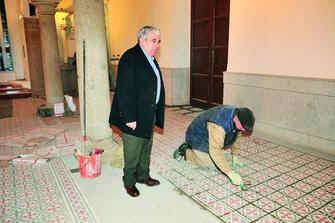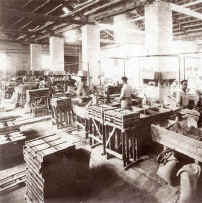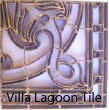

 www.ConcreteCottage.com
www.ConcreteCottage.com
Chronicles of the Design & Construction of Two Waterfront Hurricane Proof Dry Stack Modular Green Custom Homes
1. Villa Lagoon, Wilder Italian Style Home
2. Nasello Italian Style Home
Encaustic Cement Floor Reproduction Tiles---Colored Concrete Tiles

Look to Villa Lagoon Tile for Encaustic Cement Tiles for accurate historical and antique cement tile reproductions.
Send us your articles about historic tile floor repairs or reproduction.
Spanish Mosaico Hidraulico Floors Restored in a Church in Cordoba - 2009
 |
The councilman visits the work of replacing the flooring. |
Here is a Google auto-translation and the original Spanish: The Consistory repairs inside the shrine before the pilgrimage LunaThe City Council will install a new granite pedestal under the dome of the temple so that devotees can surround the image of the Virgin next February 15 A. A., Pozoblanco | Updated 23.01.2025 - 11:07 The City Council is reforming Pozoblanco the sanctuary of Our Lady of the Moon for the next pilgrimage on February 15. According to a councilman's Day Works and Services vallesano Consistory, the socialist Francisco Lopez Cobos, jobs are valued at 34,500 euros and will be covered by a grant from the Delegation of the Employment Board. One of the big news is the placement of a pedestal of 1.40 meters in height to contain the image of Our Lady of the Moon during festive events to be held in his honor. The granite pedestal is designed and placed just under the dome of the shrine, which will move the stands. The aim is that the brothers can encircle the image during their Marian devotion and even closer to his devotees. But is not the only one planned in this work, which significantly reformed the interior of the temple mariano. In this way, it is replacing all the flooring inside the temple, very damaged. The new pavement is inspired by the mosaics hydraulic principles of the twentieth century, similar to those that can still be seen inside the large houses of the county of Los Pedroches. On the outside is almost completed the paving of the courtyard of the house Pozoblanco. In addition, the councilman of Works and Services reported that it was painted around the exterior of the shrine and that all work will be ready a week before the massive influx of pilgrims to the site of La Jara, who is in the municipality of Pozoblanco. While during the renovation of the chapel, the carving of the Virgin has been brought to the House of the Brothers of Villanueva de Cordoba. Once completed the work, the image is placed on the new granite pedestal made by the City of Pozoblanco with the subsidy from the Ministry of Employment. This project is also generating new jobs, such as masons six (one officer) and three painters who have been working for several weeks in one of the most venerated of the region of Valle de Los Pedroches. Three years ago, the Consistory and public services built around the shrine, and a group of about eight bars to serve the pilgrims. Moreover, the City Council is finalizing the usual security plan for the pilgrimage and has already contacted both the Civil Guard and private security forces to monitor the smooth running of an event that annually brings together some 20,000 people in this enclave. |
Now in the Original Spanish: El Consistorio repara el interior del santuario de Luna antes de la romeríaEl Ayuntamiento instalará un nuevo pedestal de granito bajo la cúpula del templo para que los devotos puedan rodear la imagen de la Virgen el próximo 15 de febrero A. A., Pozoblanco | Actualizado 23.01.2025 - 11:07 El concejal de Obras visita los trabajos de reposición de la solería. El Ayuntamiento de Pozoblanco está reformando el interior del santuario de la Virgen de Luna para la romería del próximo 15 de febrero. Según informó a El Día el concejal de Obras y Servicios del Consistorio vallesano, el socialista Francisco López Cobos, los trabajos están valorados en 34.500 euros y serán sufragados gracias a una subvención de la Delegación de Empleo de la Junta. Una de las grandes novedades será la colocación de un pedestal de 1,40 metros de altura en el que se colocará la imagen de la Virgen de Luna durante los actos festivos que se celebrarán en su honor. El pedestal está diseñado en granito y se colocará justo debajo de la cúpula del santuario, por lo que se moverán las gradas. El objetivo es que los hermanos puedan rodear a la imagen mariana durante su veneración y acercarla aún más a sus devotos. Pero no es la única intervención prevista en estos trabajos, en los que se reformará de forma notable el interior del templo mariano. De esta forma, se está sustituyendo toda la solería del interior del templo, muy deteriorada. El nuevo enlosado está inspirado en los mosaicos hidráulicos de principios del siglo XX, similares a los que todavía se pueden observar en el interior de las grandes casas solariegas de la comarca de Los Pedroches. En la parte exterior esta casi concluido el empedrado del patio de la Casa de Pozoblanco. Además, el propio concejal de Obras y Servicios informó de que se pintará todo el exterior del santuario y que todos los trabajos estarán listos una semana antes de la llegada masiva de peregrinos hasta el paraje de La Jara, que está en el término municipal de Pozoblanco. Mientras duran las obras de reforma de la ermita, la talla de la Virgen ha sido trasladada hasta la Casa de los Hermanos de Villanueva de Córdoba. Una vez concluyan los trabajos, la imagen se colocará sobre el nuevo pedestal de granito adquirido por el Ayuntamiento de Pozoblanco con la subvención de la Consejería de Empleo. Este proyecto también está generando nuevos puestos de trabajo, como son los de seis albañiles (uno de ellos oficial) y tres pintores, que llevan ya varias semanas trabajando en uno de los parajes más venerados de la comarca del Valle de Los Pedroches. Hace tres años, el Consistorio ya construyó unos servicios públicos en el santuario y hace unos ocho un grupo de bares para atender a los romeros. Por otra parte, el Ayuntamiento está ultimando el habitual plan de seguridad de la romería y ya ha contactado tanto con la Guardia Civil como fuerzas de seguridad privada para vigilar el buen funcionamiento de una cita que cada año reúne a unas 20.000 personas en este enclave. |
Link to the original page: An 2009 article about the restoration of a church in Cordoba, Spain. | |

Some say the original technique was developed in 18th century in Italy using natural colors of granite and marble dust and cement. According to one website, " the encaustic cement tile appeared at the end of the XIX century, in the south of France. Several sources say the first encaustic tiles were made in France near the country's first Portland cement plant. Until the 1920's, they were considered as high-end ultimate flooring that decorated the palaces of the Tsar, the mansions of the Côte d'Azure, Gaudi's Barcelona and Berlin's official buildings. Later on, the encaustic cement tile expanded as a creative and durable coating all over Europe, and the French, Spanish and Portuguese colonies. Around the 50's the Mosaic Hydralico lost importance and was replaced by less labor intensive, and less colorful floors. At the beginning of the XXI century, the trend for authentic products has brought back into fashion the encaustic cement tile.


It has never been possible to create an industrialized product that can substitute this handmade tile. The variety of colors, the matt finish and the soft silky texture are characteristics that make this tile absolutely unique. It is very important to note that no two tiles are exactly alike.
More Photos of old historic cement tiles
Hidraulicos antiguos, ladrilhos hidráulicos, mosaico hidraulico, encaustic cement tiles, ladrilho de água, mosaicos cementos, hydraulic floor tile, encaustic tiles, hidraulico, hydraulic tiles, ladrilhos hidráulicos, carreaux de ciments, Spanish mission tiles, redondo tile, rajoles hidràuliques, baldosas hidráulicas, pasta potosi, hidraulicos antiguos, mosaico hidraulico, mosaicos hidralicos, mosaics de pasta, baldosas decoradas, hidráulicas de cemento, baldosas, baldosa, mosaico, pavimento... all names for the same type of floor tile.

